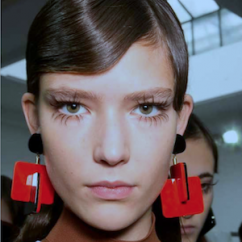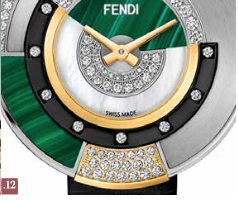Articles and News
Insights From Top-Level Jewelry Trend Forecaster Paola DeLuca | July 05, 2017 (2 comments)

New York, NY—“Fashion is ephemeral. It’s not a way to run a company.”
This statement might seem odd coming from the jewelry industry’s leading trend forecaster, Paola DeLuca of The Futurist Ltd. Speaking at the spring Gold Conference sponsored by Initiatives in Art & Culture, DeLuca defined trend forecasting as connecting consumers and the world they live in.
“People think trends are associated with the catwalk. That’s not it. It’s linking the dots between consumers, world events, and global luxury and jewelry.” Like it or not, politics is part of our business, said DeLuca. Environmental changes, both literal—with heightened concern among consumers for the earth—and metaphorical, matter because things like war and financial uncertainty change people’s feelings about spending. And the cost of primary materials like gold or diamonds, also impacts jewelry design trends.
“Linking the dots is very crucial. Your future is reflection of your present, and your present is a reflection of your past. That’s why fashion is not a long-term strategy to run a company. The way to run a company is understanding why things happen, map your scenarios, and make a strategy.”
Trend forecasting is using historical data to determine the direction of the future and, for a company, how to allocate its budget. “It’s not about pretty stuff. It’s about the demand for the goods and services a company offers compared to the cost of producing them. It also provides an important benchmark for firms that have a long-term perspective of operations. If we are serving the consumer, we need to know their lifestyle.”
For example, that understanding has impacted design shifts toward mixed media in the last decade. Expensive gold led to the trend to mix fine with fashion—both on the body and in the same piece. Yet the concept of mixing precious metal with nonprecious material is not new. The same trend exploded at the beginning of the 20th century with designers like Coco Chanel and Fulco Verdura, who mixed shells with gold and cabochon stones and Bakelite (a precursor to plastic) and more.
“It’s never new. It follows a pattern of history, this cycle, which is why we must go back to history as a point of reference to go forward,” explained DeLuca. Still, there’s a difference between going back and a backward reference going forward. Certain elements and themes come back again and again—but it’s never quite the same.
Noted jewelry and luxury trend forecaster Paola DeLuca explaining that trend forecasting is more about analyzing the un-glamorous parts of life and understanding how they impact a business's bottom line.
DeLuca referenced the Metropolitan Museum of Art’s centennial exhibition of photographer Irving Penn. “It’s no coincidence how much he studied society, and he’s [still] very contemporary facing what we are right now,” she said.
Modern brands. Branded jewelry, which in 2003 accounted for about 10% of the total fine jewelry market, is expected to account for between 30% and 40% by 2020, according to analysis by McKinsey and DeLuca.
A brand is a product with a philosophy, a meaning, she said. “It’s not all the David Yurmans or Cartiers. A brand stands for an authentic and truthful message being communicated consistently. It’s a new dialogue with the consumer.” Technology has allowed designers to speak directly with the consumer, and the message goes both ways.
“The concept of luxury from top to bottom is no more. Hermès dictating laws is no more. Companies in Paris are hiring unknown designers to be their antennas to larger audiences because they understand it’s no longer about aristocracy, royalty, or the very high end.”
Whether you’re creating one, 100, or 5000 pieces, the important thing is to listen to what people need, she said. “Retail becomes a wall between manufacturers and designers and the audience when the retailer doesn’t take a chance.”
That doesn’t mean basics are irrelevant: styling and creating a story around basic pieces is very important. Tiffany, for example, sells a lot of basics but has found a way to relate to the audience.
The trend toward ethics and social responsibility impacts our industry significantly, DeLuca said, translating not only in correct sourcing of gold and diamonds and how to treat workers, but also translates into how you’re selling and a movement toward quality vs. quantity.
“Even companies like H&M and Zara are starting to do better product. It’s not how many pieces you own, but going back a little bit and being conscious about money.” While there still will be disposable items like the T-shirt you throw away, the price of those items is going to be a very important political issue in the future, she said.
“How can a T-shirt be $10 when a worker, just to have all his taxes paid and everything, costs maybe $50? How does that work? This is an equation politicians will have to do, and it doesn’t work. We have to focus on quality product, and accept that we have to pay the money [for it.]” But if people don’t understand the difference of the better good, it’s going to reflect on the economy, she added.
She also addressed globalism, positive and negative. “We live in a global age but we are only starting to know what it means to be global and to be wired. It’s a good thing that without boundaries we are talking to other side of world in seconds, but we’re also facing economic issues. In Europe, Brexit is an extreme reaction of society, but to historians and people like me it’s not surprising, it’s in the cards. But now it’s important to read these phenomena when planning our companies and collections.”
Also on the horizon, predicts DeLuca, is a huge surge in design from China. “Creative people are taking inspiration from travel and local culture, and reinterpreting and packaging it in a different way. I’m Italian and we’re known for designers, but in China new designers take thousands of years of heritage and translate it for the 21st century and they’re going to be fantastic.”
Key trends. The idea that time holds priority in consumers’ lives translates into timeless product, says DeLuca. Luxury goods of the future will transcend seasons, and fluidity of lifestyle impacts design, such as the trend for athleisure wear that can go straight from yoga to dinner. Also, particularly among Millennials, gender can be very fluid—conventional boundaries no longer apply. “Collections that are versatile are very important,” she said. In terms of actual styling, look for geometric and Art Deco-inspired design, and breezy lightness. “A lightweight minimalistic direction is very important worldwide, usually with diamond accents. It’s not expensive but consumers have a very high perception of diamonds.” Look for small rings, collectible pieces, and body jewelry, with inspiration coming from the streets.

A watch from Fendi typifies the "re-Deco" trend DeLuca sees. At top of page, large geometric earrings on the catwalk at Marni.
The Midult, again. DeLuca thinks marketers’ ‘all Millennials all the time’ focus is a big mistake.
“Everyone is talking about Millennials, but what about people 40 and up? Are you killing them off? People are living to be 100, so if you’re 40 you’ve got another 60 years to live! All the magazines are about Millennials, but then there’s [92-year-old fashion icon] Iris Apfel. What’s up with that?”
What’s up with that is that companies are hiring older women as models because older women spend money. “The affluent Midult is age 35 to 65 and even more. These people are buying jewelry up to $2000 online. Don’t ignore them.”
She also cited an increasingly anti-hedonist life view. “Gen-X and Boomers had booze, sex, and truancy firmly at top of their to-do list. A new wave of young people is leaning toward a less risqué lifestyle, with alcohol-free bars and yoga and meditation replacing old bar and club format. They’re the new hippies.”
Millennials’ values also can change business dramatically. They’re motivated to do well, whether in taking care of their family, improving their local communities, working hard at school, college, university, or staying loyal to friends.
“The big players that come from the previous century, including myself, if we don’t update we are going to shut our businesses.” Some are shutting down—but some are starting up, and those indie companies are flourishing.
Forecasting, at its root, is simply planning. “If you don’t do this then you’re following, not leading.”








